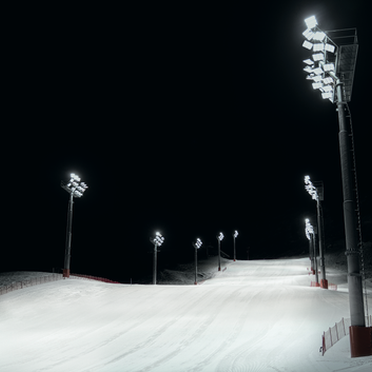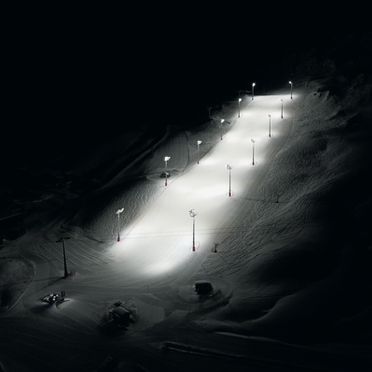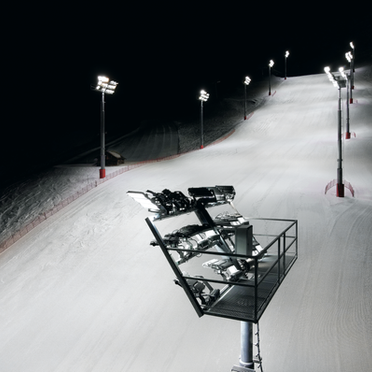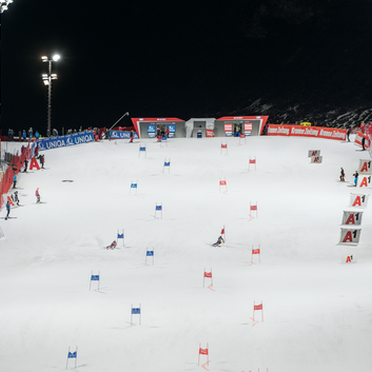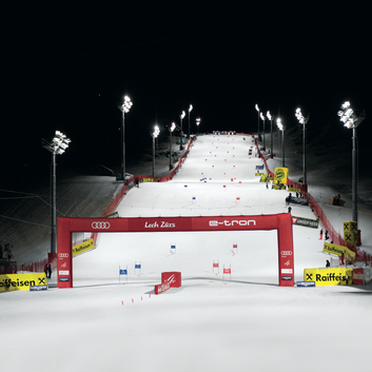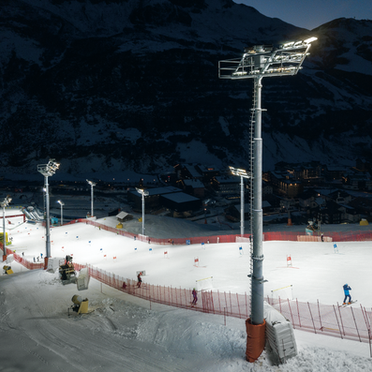Flexenarena in Zürs, Austria
- Lamp efficacy
Lamp efficacy
Ensuring the lamp efficiently converts electricity into light (lm/W).
- Ballast classification
Ballast classification
Controlling the electricity supply to the lamp (Energy Efficiency Index).
- Luminaire distribution
Luminaire distribution
Controlling light emission using optics which bend and shape the light to the correct location.
- System efficacy
System efficacy
Combining optical and thermal control within the luminaire (luminaire lm/W).
- Presence/absence detection
Presence/absence detection
Presence: Lights automatically turn on/off with movement. Absence: Lights automatically turn off and must be manually switched on.
- Daylight detection
Daylight detection
Artificial lighting which responds to the natural light conditions.
- Constant illuminance
Constant illuminance
A function designed to produce correct light levels for the duration of the maintenance period.
- Task-scene setting
Task-scene setting
Allowing the user to set scenes and adapt the lighting to different tasks.
- Timed off
Timed off
Automatic cut-off can be installed to turn all lights off during unoccupied hours.
- Task lighting
Task lighting
Lighting task areas with the correct amount of light.
- Zoning of lighting
Zoning of lighting
Lighting is zoned according to area use.
- Maintenance schedule
Maintenance schedule
Maintenance must be performed in response to product age, performance and environment.
- Waste light
Waste light
Eliminating waste light which does not hit the intended target.
- Reflectance
Reflectance
Taking advantage of light which is reflected from the surface within the space.
- Visible smart metering
Visible smart metering
Results of actions can be quickly seen as increased or decreased energy use to encourage responsible energy consumption.
Video
Click here to watch the project video
Thorn, a brand of the Zumtobel Group, supplied a state-of-the-art floodlighting system for the Flexenarena in Zürs, in the Arlberg region of Austria. For the first time in 26 years, Lech-Zürs was the venue for the Alpine World Cup and at the start of the 2020/2021 season, the men’s and women’s parallel giant slalom races were successfully held under the new floodlighting.
Just like at the kick-off event for the Skiing World Cup in Sölden, the races in Zürs were broadcast live on TV without an audience. The Thorn floodlighting system, comprising of 225 Altis luminaires, provided the best possible lighting for both the athletes on site and the spectators watching on TV. The entire project was delivered as a turnkey solution.
Project design challenges
The organisers were expecting optimal lighting with the most environmentally friendly implementation possible. The light experts' main objective was to meet the different requirements of an environmentally friendly solution. During the brief period of the World Cup, the lighting was optimised in order to meet the high requirements of TV broadcasting with regard to vertical illuminance, uniformity, light colours, glare for athletes, spectators and cameras.
After the competition, the system will offer gentle, minimal lighting with a warm colour temperature. At the end of the winter season, the system was dismantled altogether and will be re-installed at the start of the next season.
Light for the World Cup
In collaboration with all those involved, the lighting concept was designed by the Peter Samt light technology engineering firm. The concept is intended to meet all requirements without exceeding them, in order to protect the environment as much as possible. Peter Samt works with innovative and efficient solutions that actively help conserve resources and protect the environment, in order to keep emission and immission loads as low as possible.
The patented optics of Thorn’s Altis floodlights guarantee the minimum 1,200 lux vertical illuminance required for TV broadcasting, while also meeting the high requirements of vertical and camera-related uniformity.
The lighting solution
Along the 375-metre long piste, a total of twelve 22-metre tall poles (six on each side) have been positioned at a distance of 60-metre longitudinally and 50-metre crosswise from each other. On each pole, 17 Altis floodlights are used with symmetrical and asymmetrical light distributions in 5700 K and 3000 K. They are positioned and aligned in such a way that the special optics minimise any scattered light.
They meet the requirements of European standard EN 12193 "Sports lighting" and Austrian standard ÖNORM O 1052 "Light emissions – Measurement and assessment" (public skating lighting) as well as the specifications of the ORF. The standards and guidelines contain information on glare restriction and light pollution, but also take into account that the systems can be used even in poor visual conditions, such as fog or falling snow. Due to the highly reflective snow, adequate luminance with relatively low horizontal illuminance must be achieved.
For a lighting solution compatible with Full HD TV, vertical illuminance of at least 1,200 lux measured from the camera direction as well as a uniform light distribution throughout the entire recording area are required. The flicker-free lighting provided by Altis floodlights ensures uniform brightness in the recording, even in super slow motion. This is the special quality of a high-power floodlight developed for sport, and Thorn uses it to produce optimal visual conditions for the competitors and the TV audience alike.
When positioning the luminaires, the optimal balance between the number of poles and the mounting height was determined to ensure standard-compliant lighting. The individual situation on-site requires professional configuration of the floodlighting system. The slope has a gradient of up to 27 degrees and the piste has edges that are tackled with spectacular jumps. All of these slope characteristics require perfectly configured lighting.
For the World Cup, eight symmetrical Altis spotlights were also installed temporarily on two scaffolding towers in the finish area. The luminaires were angled carefully so that they would not dazzle the skiers on arrival in the finish area.
Outside of the World Cup races, the piste is used as a training site for up-and-coming skiers as well as skiing teachers and trainers. For this, only four of the floodlights on each pole are switched on with warm white light (3000 K) and individually dimmed to the minimum level. The piste is also an ideal training site for floodlit racing under competitive conditions for international competitive sport.
The right light at the right time
The LITECOM lighting controls from Zumtobel make it possible to adjust the system to the right lighting level for public skiing, up-and-coming skier training and competition (FIS World Cup) at the push of a button.
It can be operated conveniently via smartphone or tablet with an intuitive app and therefore supports sustainable handling of light in outdoor areas, so that the right light is always used at the right time.
Light that respects the environment
One of the challenges of lighting the skiing piste was to create a lighting solution that was as environmentally-friendly and energy-saving as possible, while still meeting all requirements: flicker-free and suitable for the camera, the best visual conditions for the live broadcast and fair competition conditions for the athletes. In addition, the system should be controllable in such a way that the floodlighting is always used at the required output level. All these requirements were implemented with the installed solution, entirely in-keeping with the Thorn mission "WE MAKE LIGHT WORK".

